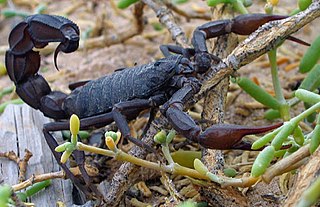
Fattail scorpion or fat-tailed scorpion is the common name given to scorpions of the genus Androctonus, one of the most dangerous groups of scorpion species in the world. The genus was first described in 1828 by Christian Gottfried Ehrenberg.

The Buthidae are the largest family of scorpions, containing about 100 genera and 1339 species as of 2022. A few very large genera are known, but a high number of species-poor or monotypic ones also exist. New taxa are being described at a rate of several new species per year. They have a cosmopolitan distribution throughout tropical and subtropical environments worldwide. Together with four other families, the Buthidae make up the superfamily Buthoidea. The family was established by Carl Ludwig Koch in 1837.
Hemiscorpius is the sole genus of the scorpion family Hemiscorpiidae, with about 16 described species. Before Hemiscorpiidae, the term used for the family was Ischnuridae, which had to be changed due to a naming conflict with the damselfly family of the same name. They at one point also held the name Liochelidae.
Buthacus is a genus of scorpion of the family Buthidae. It is distributed across northern and western Africa, Israel, Palestine, Jordan, Syria, the Arabian Peninsula, Iraq, Iran, Afghanistan, and Pakistan.
The taxonomy of scorpions deals with the classification of this predatory arthropod into 13 extant families and about 1,400 described species and subspecies. In addition, 111 described taxa of extinct scorpions are known.
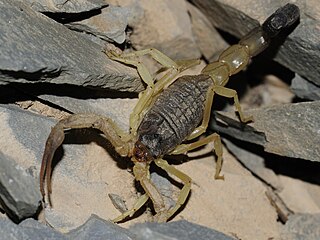
Hottentotta is a genus of scorpions of the family Buthidae. It is distributed widely across Africa, except for most of the Sahara desert. Species in the genus also occur in the Middle East, the Arabian Peninsula, southeastern Turkey, Iraq, Iran, Afghanistan, Pakistan, India, Nepal, Cape Verde Islands, and Sri Lanka (introduced).

Hottentotta tamulus, the Indian red scorpion, also known as the eastern Indian scorpion, is a species of scorpion of the family Buthidae. It occurs in most of India, eastern Pakistan and the eastern lowlands of Nepal, and recently from Sri Lanka.

Mesobuthus eupeus is a polymorphic scorpion species belonging to the well-known family Buthidae. Commonly known as the lesser Asian scorpion or the mottled scorpion. It is thought to be the most widely dispersed species of the genus Mesobuthus, perhaps even of the family Buthidae.
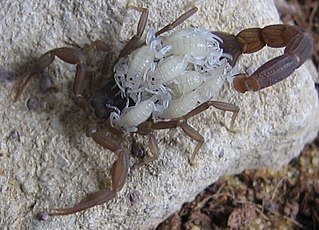
Compsobuthus is a genus of buthid scorpions.
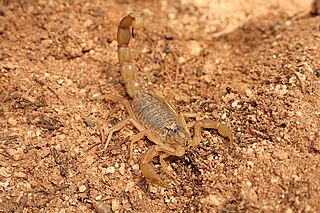
Buthus is a genus of scorpion belonging and being eponymous to the family Buthidae. It is distributed widely across northern Africa, including Morocco, Mauritania, Algeria, Tunisia, Libya, Egypt, Senegal, Guinea-Bissau, Nigeria, Sudan, Somalia, Ethiopia, Djibouti, as well as the Middle East, including Israel, Palestine, Jordan, Lebanon, Iraq, Yemen, and possibly Saudi Arabia and southern Turkey. Its European range includes the Iberian Peninsula, southern France, and Cyprus.

Chaerilus is a genus of scorpions in the family Chaerilidae. They live in tropical parts of South Asia and Southeast Asia. A fossil genus Electrochaerilus is known from the Late Cretaceous (Cenomanian) aged Burmese amber.
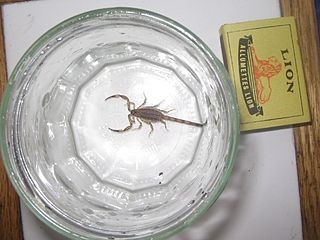
Isometrus is a genus of scorpion belonging and being eponymous to the family Buthidae. Some species are currently assigned to the genus Reddyanus.

Scorpiops is a genus of scorpions in the family Scorpiopidae. It is distributed throughout much of Asia. The taxonomy of the group is unclear because new species and subgenera are described often, and one subgroup may represent a species complex.
Hottentotta jalalabadensis is a species of scorpion of the family Buthidae. It was first found in Afghanistan.
Hottentotta stockwelli is a species of scorpion of the family Buthidae. It was first found in Andhra Pradesh and Maharashtra, India.
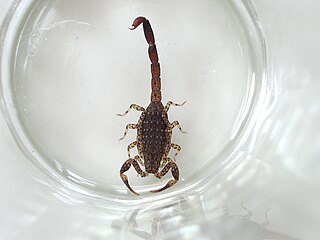
Lychas is a genus of scorpions belonging to the family Buthidae. It is one of the most widespread genus of the scorpions, where the species are found throughout in Africa and Seychelles, and in the Oriental region from India to Melanesia.

Charmus is a genus of buthid scorpions native to India and Sri Lanka.

Reddyanus is a genus of buthid scorpions native to Oriental region from India, Sri Lanka, China: Tibet, to Melanesia. The genus was previously described as a subgenus of Isometrus.
Heterometrus serratus is a species of scorpion in the family Buthidae endemic to Sri Lanka where it is restricted to southern parts.
Orthochirus is a genus of scorpion in the family Buthidae, first described by Ferdinand Karsch in 1891.












